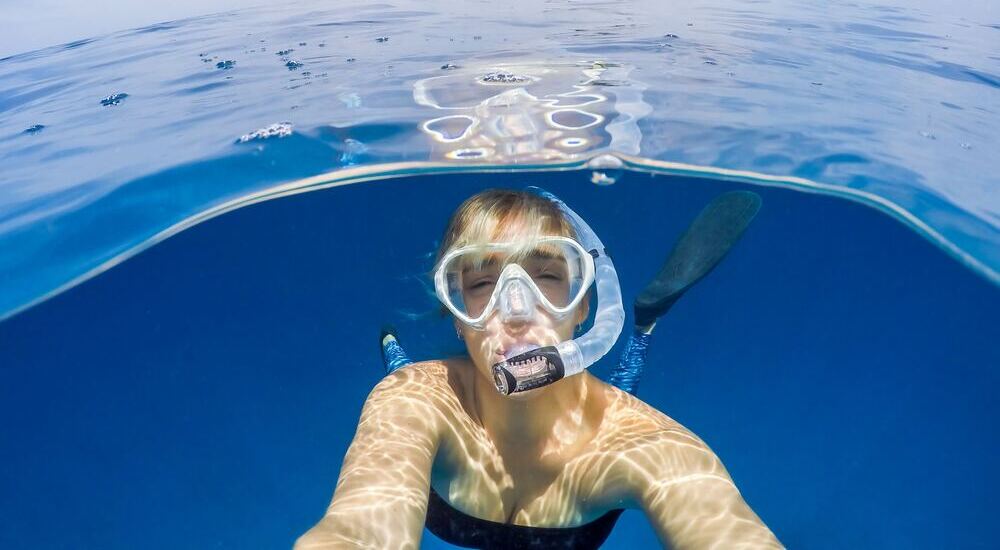When it comes to snorkeling, the joy of exploring underwater wonders is unparalleled. But this awe-inspiring experience hinges on one crucial factor – your equipment’s reliability, particularly your snorkel’s seal.
A properly sealed snorkel is your lifeline, ensuring a steady flow of air and keeping water out. Neglecting this can turn a delightful dive into a struggle, as you contend with water intrusion and breathing difficulties.
In this guide, we’ll delve into the essential steps to check if your snorkel is properly sealed, ensuring each dive is as seamless and enjoyable as the marine vistas you’re exploring. Let’s make sure your snorkeling gear is as ready for adventure as you are!
Step 1: Inspect the Mouthpiece – A Personal Ritual
Every snorkeling trip for me begins with a meticulous inspection of the mouthpiece. It’s a ritual I’ve developed over the years, understanding its crucial role in a good snorkeling experience.
Look for Wear and Tear
I closely examine the mouthpiece, checking for any signs of damage. Cracks or tears are not just about water seeping in; they can also irritate your gums or lips. I learned this the hard way on a trip to the Great Barrier Reef when a small tear in the mouthpiece caused considerable discomfort, distracting me from the stunning underwater scenery.
Flexibility Test
I give the mouthpiece a gentle squeeze and bend. It should feel supple yet firm. If it’s too stiff, it won’t form a comfortable seal; too soft, and it might collapse slightly during use, allowing water in. I remember once using a snorkel with a too-rigid mouthpiece – it not only made sealing difficult but also left me with aching jaws after a day of snorkeling.
Step 2: Check the Snorkel’s Valve – Lessons Learned
The purge valve is a feature I used to overlook, but a few snorkeling adventures later, I realized its significance in a properly sealed snorkel.
Functionality Check
I gently press the valve, feeling for its responsiveness. It should spring back into place effortlessly. If it sticks, it’s a sign that the valve might not close properly underwater, leading to potential water intake. During a snorkel session in Hawaii, a stuck valve had me swallowing more saltwater than I cared for – a lesson quickly learned!
Debris and Cleanliness
I always check for sand or small debris that might impede the valve’s function. I’ve found that even a tiny grain of sand can prevent a proper seal. Cleaning the valve is now a part of my pre-snorkel routine, ensuring that the purge mechanism works flawlessly. A snorkeling guide once shared a tip with me: after any snorkeling session, especially in sandy environments, rinse the snorkel thoroughly in fresh water to clear out any particles.
Step 3: Examine the Fit and Connection – A Personal Fit is Key
The fit of the snorkel, particularly how it connects to the mask, is something I pay close attention to, based on my experiences.
Testing the Mouthpiece Fit
I always try the mouthpiece before heading out. It should rest comfortably in my mouth without me having to bite down hard. I recall a snorkeling trip where the mouthpiece was too large, causing constant discomfort and a poor seal. It was a constant distraction, and I ended up spending more time adjusting my snorkel than enjoying the marine life.
Secure Attachment to the Mask
Ensuring that the snorkel is securely attached to the mask is crucial. I’ve had instances where a loosely attached snorkel led to water leakage. I make it a point to check the clip or strap attaching the snorkel to the mask, ensuring it’s firm and won’t come loose with movement.
Step 4: Perform a Dry Test – Trust but Verify
Before I hit the water, I perform a dry test. This step has saved me from many potential snorkeling mishaps.
Breathing Through the Snorkel
I put on my mask and snorkel and breathe through it. The air should flow freely without any resistance. If I feel any obstruction, it’s a red flag. On a trip in Belize, this step helped me identify a blockage in the snorkel tube that I’d missed during my visual inspection.
Listening for Air Leaks
As I breathe, I listen for any unusual sounds – hissing or whistling – that could indicate air escaping, which means water can get in. This practice came from a snorkeling instructor who emphasized the importance of not just feeling but also listening to your equipment.
Step 5: Conduct a Water Test – The Ultimate Seal Check
Finally, I always conduct a water test, which is the ultimate test for a snorkel’s seal.
Shallow Water Test
In a shallow area, I submerge with the snorkel in my mouth and take normal breaths. If water enters the snorkel, it should be minimal and easy to clear. This test has been a staple in my routine since an early snorkeling experience where I neglected it and ended up with a snorkel that was difficult to clear, leading to a less than pleasant snorkeling session.
Clearing the Snorkel
I practice clearing the snorkel in shallow water. The ease of clearing is a good indicator of the snorkel’s functionality. I learned the importance of this practice during a snorkeling trip in the Maldives, where swift clearing was necessary due to the dynamic water conditions.
Step 6: Regular Maintenance and Care – A Habit Worth Cultivating
Over the years, I’ve learned that regular maintenance is as important as the pre-snorkel checks. It’s about preserving the seal and longevity of your snorkel.
Post-Snorkel Cleaning
After each snorkel session, I thoroughly rinse the snorkel, especially the mouthpiece and valve, with fresh water. Salt, sand, and chlorine can degrade the materials over time. One memorable snorkeling trip off the coast of Mexico taught me this; I neglected to rinse my gear properly, and the accumulated salt caused the valve to stick during my next dive.
Periodic Deep Cleaning
Every few months, especially during regular snorkeling seasons, I take apart my snorkel for a deeper clean. This includes checking the mouthpiece and valve for any hidden debris or signs of wear. I remember discovering a small crack in the mouthpiece during one of these checks, which could have led to a significant leak on my next trip.
Step 7: Mind the Storage – Protect Your Gear
How you store your snorkel when it’s not in use is crucial for maintaining its seal and functionality.
Avoid Direct Sunlight
I always store my snorkel in a cool, dry place away from direct sunlight. UV rays can deteriorate the silicone and plastic parts, affecting the seal and flexibility. Learning this was a hard lesson after leaving my snorkel on the deck under the hot sun, resulting in a warped mouthpiece.
Keep It Straight
To maintain the shape and integrity of the snorkel, I store it in a way that keeps it straight. Bending or twisting the snorkel in storage can lead to a misshapen tube or damaged mouthpiece, affecting its sealing ability.
Step 8: Regular Upgrades – Stay Updated
Staying updated with the latest in snorkel technology is something I recommend. Gear evolves, and so do the materials and designs that can enhance your snorkeling experience.
Keep Informed
I keep an eye on the latest snorkeling gear trends and advancements. This practice has led me to upgrade my snorkel several times, each time enhancing my snorkeling experience significantly.
Personal Fit and Preference
As my snorkeling skills have grown, so have my preferences for certain types of snorkels. What worked for me as a beginner didn’t necessarily fit my needs as I became more experienced. Regularly assessing and upgrading your snorkel can make a big difference in your comfort and performance in the water.
Conclusion
Ensuring your snorkel is properly sealed is an ongoing process, encompassing pre-snorkel checks, regular maintenance, mindful storage, and staying informed about new developments. These steps, forged from personal experiences and lessons learned in diverse snorkeling conditions, are not just about ensuring a functional piece of equipment; they’re about guaranteeing a safe, comfortable, and enjoyable snorkeling experience. Remember, your snorkel is your lifeline when you’re exploring the underwater world – treat it with care, and it will ensure countless unforgettable dives. Dive in, the ocean awaits!

